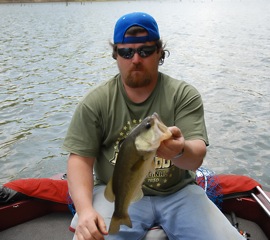By Chris Erwin
Have you ever heard the old phrase that 10 percent of the water holds 90 percent of the fish? I can tell you that is a true statement. Its been proven over and over, and if you want to have better success bass fishing, the first thing you need to learn is how to eliminate water.
All of us usually have some kind of idea what we think the fish are doing and where we want to start fishing, along with what bait we think will work the best in any given scenario. The problem we all face is: What to do when we’re wrong?
To understand better what I do, I must give credit where it is due. I didn’t figure this out on my own. Over the years, I have had many good anglers in my boat, and I’m always trying to learn from anyone that can make me more successful.

They have taught me that when you have been on the water more than two hours, and you’re not putting fish in the boat, it’s time to apply rule one.
The first rule is you can’t keep doing the same thing and expect to have a different result. I don’t start changing baits. Instead, I start evaluating the locations I’m fishing.
This past weekend I expected to catch fish in old spawning areas, places like sandy flats, roadbed edges, and humps that I know to be spawning areas. While I did catch a few fish, I spent about four hours checking out these areas with little success. It was time to move to a different type of bank or some deep water structure. I have a list of bank types that have proven productive in the past, and it was time to start jumping around until I could form a better idea of what the fish were using.
[Tip – My list contains: Rip Rap large rocky shore line, Standing channel trees, deep banks that have trailing shell and rock in channel bends, Old bridge foundations, feeder creeks, points that drop off quick, bottle-neck coves with flowing creeks, weed edges, and laydown trees, which drop into deep water]
I use two basic baits to find fish, a spinnerbait and a crankbait. Once I locate fish, I may switch to a slower bait, like a jig or a worm, but I consider these baits to slow to find fish.
As Saturday was drifting into evening, I only had 10 fish to my credit. But a pattern was becoming clear. The fish were on banks near the channel, but more precisely the bank needed to have trailing broken rock that dropped off quickly to deep water. Long flats were fruitless.
Starting the day on Sunday, my son and I had a new plan. Indeed, the day started very differently from the previous one. On one stretch of bank about 100 feet long produced 20 fish. As we jumped from one location to another, our pattern held up.
By the end of the day, we had 57 bass, but only 3 over 16 inches. About 20 were 10 to 13 inches, the low end of the slot limit on Cave Run. The balance was in the middle of the slot. We only count fish and we don’t keep bass or musky and our little rule between us is that we don’t count fish under 10 inches or any fish we don’t touch.
It turned out to be a fun day.
Scott, my son, did hook a really good musky on Sunday from a lay-down tree that was also in our pattern. The fish gave him a good fight but pulled out about halfway back. The fish looked to be near 40 inches.
Till next time, good fishing!



Be the first to comment